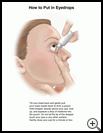
Eye Drops and Ointments: How to Use
________________________________________________________________________
KEY POINTS
- Always use eyedrops or ointments exactly as prescribed. Never share eye medicines with others or use drops prescribed for a different eye problem.
- Before you put any medicine in your eyes, wash your hands thoroughly.
- If you develop any new redness or irritation while you are using your medicine, contact your healthcare provider.
________________________________________________________________________
It is important to use eye drops or ointments correctly. Some general guidelines are:
- Always use the amount of medicine your healthcare provider has prescribed. Do not use it more or less often than prescribed.
- Never share eye medicines with others or use drops prescribed for a different eye problem.
- Before you put any medicine in your eyes, wash your hands thoroughly.
- Read the label on the medicine to make sure you have the correct medicine. Some eyedrop bottles and ointment tubes look like other medicines or chemicals.
- Do not use eye drops that are outdated or discolored. Not all eye drops are clear. Ask your eye care provider or pharmacist about the color of the medicine if you have any questions.
- If you develop any new redness or irritation while you are using your medicine, contact your healthcare provider.
- If you have been prescribed both eye drops and eye ointment, always put the eye drops in before the ointment.
- If you have been prescribed more than one eye medicine, use one and then wait at least 5 minutes before using the next one, or as long as recommended by your healthcare provider. This keeps the second medicine from washing out the first one.
- Eye drops can be absorbed by your body and cause side effects like other medicines. They can also interact with other medicines. List your eye drops when you are asked about the medicines you take. Let your eye care provider know if you are pregnant, trying to become pregnant, or breast-feeding.
How are eye drops used?
- Shake the bottle well.
- Tilt your head back or lie down, and pull your lower eyelid down to form a pouch.
- Hold the bottle directly above your eye. Look up, and squeeze 1 drop of the medicine into the pouch. (Usually an extra drop is not harmful, but you may run out of the medicine too quickly.) To keep from contaminating the medicine, do not let the tip of the bottle touch your eye or any other surface.
- Close your eye for a minute or two, and with a fingertip press gently on the inside corner of your eye, next to your nose to keep the medicine from draining out. Do not rub your eye.
- Put the cap back on tightly, and store the medicine away from heat and bright light. Some drops may need to be kept in the refrigerator.
If you have trouble using eye drops, ask someone to help.
How are eye ointments used?
- Hold the tube of ointment in your hand for a few moments. This will warm the medicine so it will flow easily from the tube. Do not use ointment that has dried out.
- Tilt your head back or lie down, then pull your lower eyelid down to form a pouch.
- Look up, and squeeze the amount of ointment prescribed by your healthcare provider into the pouch. To keep from contaminating the medicine, do not let the tip of the tube touch your eye or any other surface.
- Blink a few times to help spread the ointment over your eye. Do not rub your eye.
- Put the cap back on the tube tightly, and store the medicine away from heat and bright light.
If you have trouble using eye ointments, ask someone to help.
Your vision may be blurry for some time after using your ointment. Avoid driving and other activities that require good vision until you can see clearly.
Can I wear contact lenses while I am using eye medicines?
Ask your healthcare provider about wearing contacts while you are using your eye medicine. Some eye medicines should not be used if you wear contact lenses. Some medicines can stain contacts, and if ointment gets on the contact lens, the lens will need to be thrown away. Do not put medicine in your eyes while your contacts are in your eyes, unless they are lubricating eye drops made for contact lens wearers.
If you have any questions about using your eye medicines properly, ask your healthcare provider.

